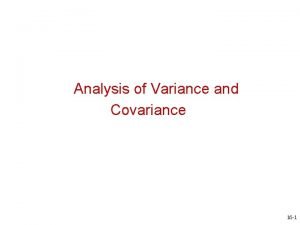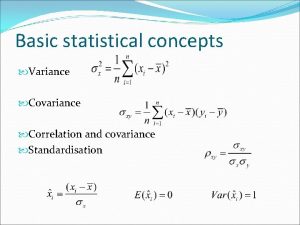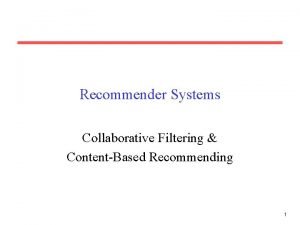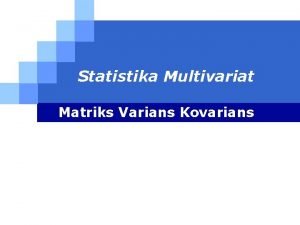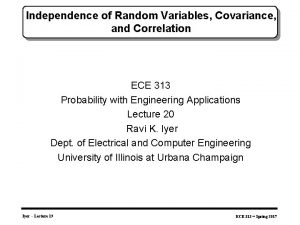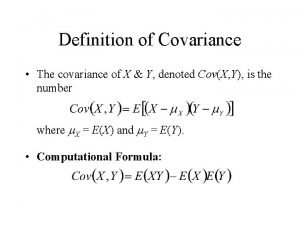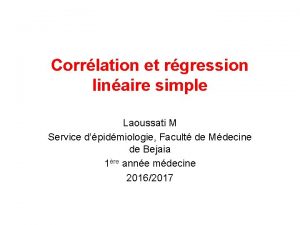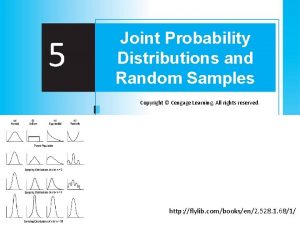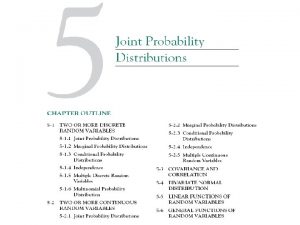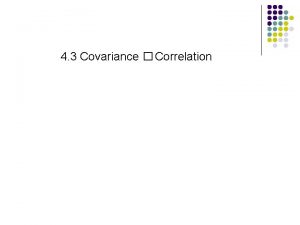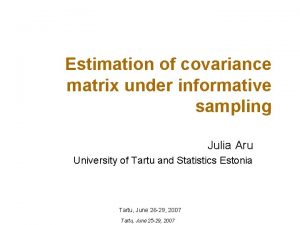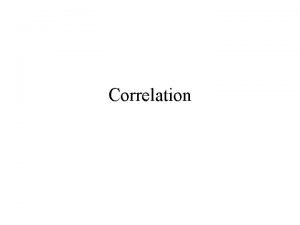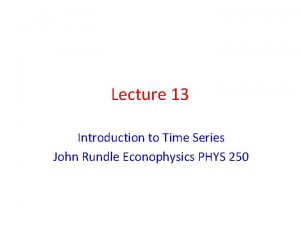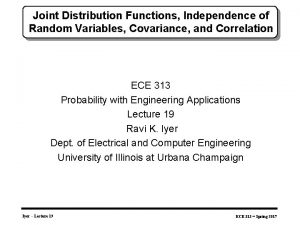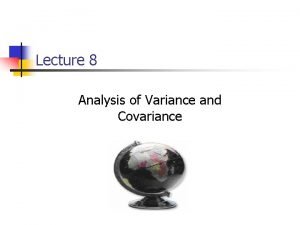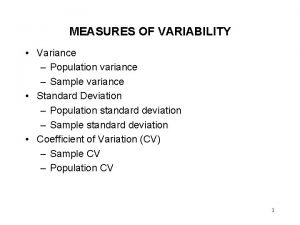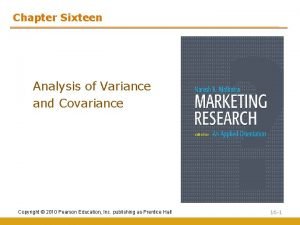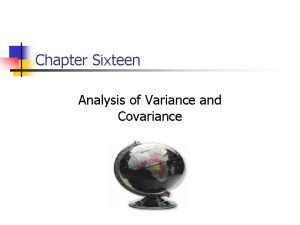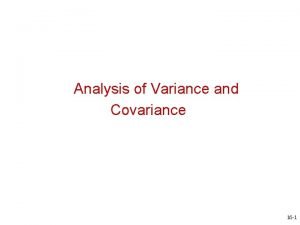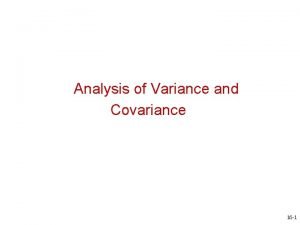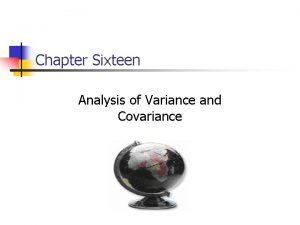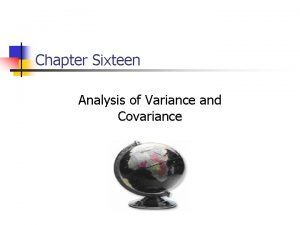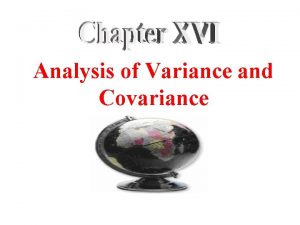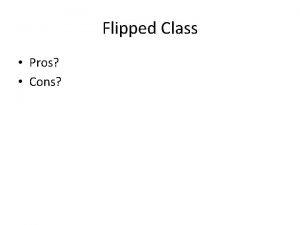Analysis of Variance and Covariance Effect of Coupons

















- Slides: 17

Analysis of Variance and Covariance

Effect of Coupons, In-Store Promotion and Affluence of the Clientele on Sales 16 -2

16 -3 Relationship Among Techniques n n n Analysis of variance (ANOVA) is used as a test of means for two or more populations. The null hypothesis, typically, is that all means are equal. Analysis of variance must have a dependent variable that is metric (measured using an interval or ratio scale). There must also be one or more independent variables that are all categorical (nonmetric). Categorical independent variables are also called factors.

16 -4 Relationship Among Techniques n n A particular combination of factor levels, or categories, is called a treatment. One-way analysis of variance involves only one categorical variable, or a single factor. In one-way analysis of variance, a treatment is the same as a factor level. If two or more factors are involved, the analysis is termed n-way analysis of variance. If the set of independent variables consists of both categorical and metric variables, the technique is called analysis of covariance (ANCOVA). In this case, the categorical independent variables are still referred to as factors, whereas the metricindependent variables are referred to as covariates.

Relationship Amongst t-Test, Analysis of Variance, Analysis of Covariance, & Regression 16 -5 Metric Dependent Variable One Independent Variable One or More Independent Variables Binary Categorical (factors) Categorical (f-rs) Interval covariates Metric t Test Analysis of Variance Analysis of Covariance Regression One Factor More than One Factor One-Way Analysis of Variance N-Way Analysis of Variance

Illustrative Applications of One-way Analysis of Variance 16 -6 We illustrate the concepts discussed in this chapter using the data presented in Table 16. 2. The department store is attempting to determine the effect of in-store promotion (X) on sales (Y). For the purpose of illustrating hand calculations, the data of Table 16. 2 are transformed in Table 16. 3 to show the store sales (Yij) for each level of promotion. The null hypothesis is that the category means are equal: H 0: µ 1 = µ 2 = µ 3.

16 -7 Effect of Promotion and Clientele on Sales Table 16. 2

One-Way ANOVA: Effect of In-store Promotion on Store Sales 16 -8 Table 16. 3 Source of Variation Between groups (Promotion) Within groups (Error) TOTAL Sum of squares 106. 067 df 2 Mean square 53. 033 79. 800 27 2. 956 185. 867 29 6. 409 Cell means Level of Promotion High (1) Medium (2) Low (3) Count Mean 10 10 10 8. 300 6. 200 3. 700 TOTAL 30 6. 067 F ratio F prob. 17. 944 0. 000

16 -9 N-way Analysis of Variance In business research, one is often concerned with the effect of more than one factor simultaneously. For example: n n n How do advertising levels (high, medium, and low) interact with price levels (high, medium, and low) to influence a brand's sale? Do educational levels (less than high school, high school graduate, some college, and college graduate) and age (less than 35, 35 -55, more than 55) affect consumption of a brand? What is the effect of consumers' familiarity with a department store (high, medium, and low) and store image (positive, neutral, and negative) on preference for the store?

16 -10 Two-way Analysis of Variance Table 16. 4 Source of Variation Main Effects Promotion Coupon Combined Two-way interaction Model Residual (error) TOTAL Sum of squares df Mean square F Sig. of F 106. 067 53. 333 159. 400 3. 267 2 1 3 2 53. 033 53. 333 53. 133 1. 633 54. 862 55. 172 54. 966 1. 690 0. 000 0. 226 162. 667 5 23. 200 24 185. 867 29 32. 533 0. 967 6. 409 33. 655 0. 000 2 0. 557 0. 280

16 -11 Two-way Analysis of Variance Table 16. 4 cont. Cell Means Promotion High Medium Low TOTAL Coupon Yes No Count 5 5 5 Mean 9. 200 7. 400 7. 600 4. 800 5. 400 2. 000 30 Factor Level Means Promotion High Medium Low Coupon Yes No Grand Mean Count 10 10 10 15 15 30 Mean 8. 300 6. 200 3. 700 7. 400 4. 733 6. 067

16 -12 Analysis of Covariance When examining the differences in the mean values of the dependent variable related to the effect of the controlled independent variables, it is often necessary to take into account the influence of uncontrolled (usually metric) independent variables. For example: n n n In determining how different groups exposed to different commercials evaluate a brand, it may be necessary to control for prior knowledge. In determining how different price levels will affect a household's cereal consumption, it may be essential to take household size into account. We again use the data of Table 16. 2 to illustrate analysis of covariance. Suppose that we wanted to determine the effect of in-store promotion and couponing on sales while controlling for the effect of clientele. The results are shown in Table 16. 6.

16 -13 Analysis of Covariance Table 16. 5 Source of Variation Covariance Clientele Main effects Promotion Coupon Combined Sum of Squares df Mean Square Sig. of F F 0. 838 1 0. 838 0. 862 0. 363 106. 067 2 53. 033 54. 546 0. 000 53. 333 1 53. 333 54. 855 0. 000 159. 400 3 53. 133 54. 649 0. 000 3. 267 2 1. 633 1. 680 0. 208 27. 251 0. 972 6. 409 28. 028 0. 000 2 -Way Interaction Promotion* Coupon Model Residual (Error) TOTAL Covariate Clientele 163. 505 22. 362 185. 867 Raw Coefficient -0. 078 6 23 29

Issues in Interpretation 16 -14 Multiple Comparisons n n If the null hypothesis of equal means is rejected, we can only conclude that not all of the group means are equal. We may wish to examine differences among specific means. This can be done by specifying appropriate contrasts, or comparisons used to determine which of the means are statistically different. A priori contrasts are determined before conducting the analysis, based on the researcher's theoretical framework. Generally, a priori contrasts are used in lieu of the ANOVA F test. The contrasts selected are orthogonal (they are independent in a statistical sense).

Issues in Interpretation 16 -15 Multiple Comparisons n A posteriori contrasts are made after the analysis. These are generally multiple comparison tests. They enable the researcher to construct generalized confidence intervals that can be used to make pairwise comparisons of all treatment means. These tests, listed in order of decreasing power, include least significant difference, Duncan's multiple range test, Student-Newman-Keuls, Tukey's alternate procedure, honestly significant difference, modified least significant difference, and Scheffe's test. Of these tests, least significant difference is the most powerful, Scheffe's the most conservative.

16 -16 Multivariate Analysis of Variance n n n Multivariate analysis of variance (MANOVA) is similar to analysis of variance (ANOVA), except that instead of one metric dependent variable, we have two or more. In MANOVA, the null hypothesis is that the vectors of means on multiple dependent variables are equal across groups. Multivariate analysis of variance is appropriate when there are two or more dependent variables that are correlated. If they are uncorrelated, use ANOVA on each of the dependent variables separately rather than MANOVA.

16 -17 SPSS Windows One-way ANOVA can be efficiently performed using the program COMPARE MEANS and then One-way ANOVA. To select this procedure using SPSS for Windows click: Analyze>Compare Means>One-Way ANOVA … N-way analysis of variance and analysis of covariance can be performed using GENERAL LINEAR MODEL. To select this procedure using SPSS for Windows click: Analyze>General Linear Model>Univariate …
 Multivariate analysis of variance and covariance
Multivariate analysis of variance and covariance Analysis of variance and covariance
Analysis of variance and covariance Covariance correlation
Covariance correlation Standard costing and variance analysis formulas
Standard costing and variance analysis formulas Covariance and standard deviation
Covariance and standard deviation Matriks kovarian adalah
Matriks kovarian adalah Section 6-5 coupons and rebates answers
Section 6-5 coupons and rebates answers Covariance between two random variables
Covariance between two random variables Covariance formula
Covariance formula Covariance formula
Covariance formula Covariance formule
Covariance formule Covariance properties
Covariance properties Joint random variables
Joint random variables Covariance definition
Covariance definition Julia covariance matrix
Julia covariance matrix Correlation covariance
Correlation covariance Covariance of two time series
Covariance of two time series Covariance of joint distribution
Covariance of joint distribution

